You’ve probably interacted with an app on your phone or tablet that’s slow, takes a long time to load, freezes, or even crashes on you altogether.
Frustrating, right?
On the flip side, you can probably think of an app that you love to use because from day one, it’s never given you any trouble.
Or maybe you never paid any mind to an app that works quickly, because isn’t that how it’s supposed to be?
So, what causes one app to be crash-prone and another, fast, and reliable?
Whether an app has good or bad performance depends on three factors: the backend, the network, and the app itself running on the device.
A developer or mobile tester can measure the performance of an application in different scenarios.
For example, they can test for when there’s a concurrency of users on the app at the same time, on different devices (which vary in hardware resources and screen sizes), and multiple networks such as 3G, 4G, Wifi, and more.

The reality is that many variables affect the performance of a mobile application. Moreover, a user may have a very bad experience with your app and the cause might not even have anything to do with the code or its implementation.
But, by running performance tests for each of these three factors, you’ll be able to identify problems and optimize your app for the best user experience possible.
Keep reading as we’ll cover the different types of tests for each factor, what to measure, and what tools are available to help you along the way.
1st Mobile Performance Factor: The Backend
A mobile app’s backend architecture is generally based on an application server, a web server, and a database.
**When it comes to the backend, the things related to performance that are important to know when an app is under load are the server’s response times, database queries times, and the server’s resource usage. **
Using this information, it’s easier to detect issues such as:
- High server response times
- Bottlenecks or breakpoints in the database and application server resources
- Poor implementation of escalation policies
So what kind of tests are normally run to check the app’s backend performance? Load tests.
This is when you simulate load on the backend in different ways, whether it be through stress testing, peak testing, endurance testing, load testing, etc.
In general, the objective of these tests is to understand how the backend systems of an app behave and handle a certain volume of concurrent users.
Several tools allow you to load test your mobile app. The most commonly used ones include:
Apache JMeter – the number one open-source load testing tool
Gatling– a developer-friendly, open-source load testing tool with scripts written in Scala
BlazeMeter – a cloud performance testing platform that scales your JMeter or Gatling tests for a greater amount of concurrent users
2nd Mobile Performance Factor: The Network
With regards to the network that the device is connected to, there are two key things to measure: latency and bandwidth.
- Latency is the time that elapses when information is sent on the network (measured in milliseconds).
- Bandwidth is the maximum capacity (the amount of data) that can be transmitted through the network (measured in bits per second).

For mobile performance, the lower the latency and the higher the bandwidth, the better.
An app’s performance can vary depending on, for example, whether it’s connected to a 3G network or a 4G network, and unfortunately, this is beyond an app developer or tester’s control.
But, it is possible to incorporate the network during the mobile app performance testing process, simulating the different types of networks and measuring their impact on the response times, both on the server-side and the client-side.
#tutorial #performance #mobile apps #load testing #mobile testing #mobile app performance #client side performance
